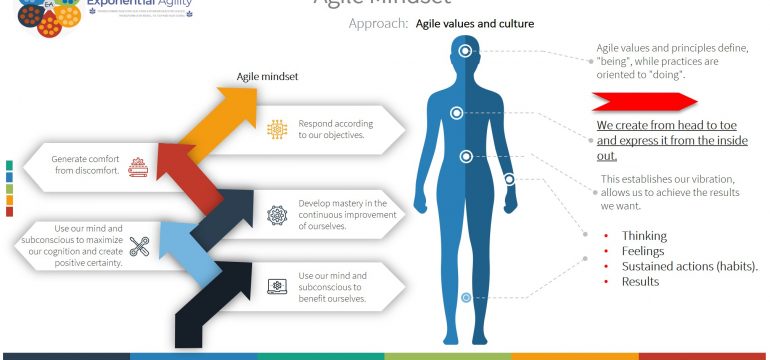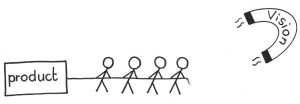Our bodies were not built to cope with stress on a sustained basis. Our brain is designed to survive and react innately. Today we no longer see a lion, and our first reaction is to run, the dangers are different and the response should also be different, we need to be very aware of this. We need to respond differently to new and complex experiences, it is important to disassociate our mind and our body, from genetic reactions, culturally learned, through a new way of thinking, to create strength and mental muscle to face uncertainty and make sure we have access to our maximum cognitive capacity, unlearning our genetic and cultural reactions.
An agile mindset is based on increasing awareness and generating internal leadership mastery, responding according to our goals, generating comfort from discomfort, developing continuous improvement of ourselves, using our mind and subconscious to maximize our cognition and beliefs for the benefit of ourselves and our interaction.
Agile values and principles define, “being”, while practices are oriented to “doing”, the change begins in our intellectual mind and through praxis, we generate new habits, which allow us to achieve results in a sustained way, for this reason it is important to know our direction and purpose, we live from head to toe and express it from the inside out, this establishes our vibration, allows us to achieve the results we want.

Actionable learning is one of the relevant skills part of an agile mindset that implies putting aside psychological risk, improving the learning process, exceeding the established achievement, we create the minimum, necessary to act, we discover and at the same time we deliver value. The last responsible moment is another relevant skill, decisions become critical, when times change rapidly, the more uncertain a situation is, the more we yearn for certainty, responding by maximizing the time available, to satisfy critical criteria is of vital importance.
Possibilities arise when we believe in ourselves, we accept ourselves, we are not perfect and we live in an imperfect world, we prioritize based on value and thereby define objectives, we focus on verification and data (avoid cognitive biases), we are resilient, we convert losses in opportunities and we de-escalate and simplify to act.
In this way, we iteratively generate resilience, to recover and learn quickly, turn losses into gains, moving from survival to prosperity, remembering that the error is one more performance data, a data, a chronic state of learning, an attempt, below the proposed objective, leaving an impression of increase, of progress, taking the best of people.
Miguel Martínez. August 16, 2021.
Bibliography:
- Blanchard, K. H., & Broadwell, R. (2018). Servant leadership in action: How you can achieve great relationships and results. Oakland, Ca: Berrett-Koehler ,, a BK Business book.
- Dweck, C. S. (2016). Mindset: The new psychology of success. New York: Ballantine Books.
- Hauck, C. (2021). Shine: Ignite your inner game to lead consciously at work and in the world. Sounds True.
- Proctor, B. (2007). You were born rich: Now you can discover and develop those riches. LifeSuccess.
- Koestenbaum, P. (2010). Leadership: The inner side of greatness: A philosophy for leaders. San Francisco, CA: Jossey-Bass.






















